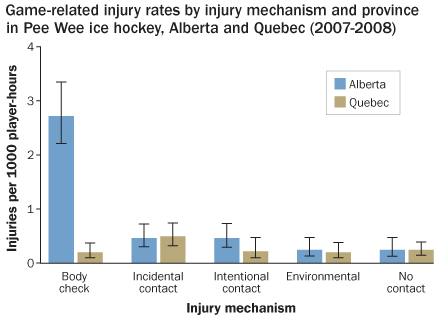In youth hockey, more contact means more injuries
Number of concussions tripled in leagues that permit checking
Children playing ice hockey in leagues that allow body checking have more concussions and other injuries than do youngsters in leagues that prohibit checking, a Canadian study of preteens shows. The work appears in the June 9 Journal of the American Medical Association.

Checking in hockey is akin to blocking in football. But in hockey it’s a defensive hit, in which a player attempts to stop or limit the progress of an offensive player who has the puck. While a check cannot be delivered with the elbows, knees or a hockey stick, it can involve a violent collision. Some local youth leagues disallow checks among preteens, and the entire province of Quebec banned checking for all players ages 12 and under in the late 1980s. Alberta hasn’t.
Researchers enlisted 74 youth hockey teams in Alberta and 76 in Quebec in the new study, which included more than 1,000 players in each province. Each team had a physical trainer or other adult who recorded injuries to the team’s players during an entire season’s games and practices. All children were ages 11 or 12, a group referred to in Canada as the Pee Wee League. Nearly all were boys, and all wore helmets and mouth guards during play.
There were 209 injuries, including 73 concussions, during games involving the Alberta players. The Quebec teams, which don’t allow checking, suffered 70 game-related injuries, of which 20 were concussions. Doctors verified the injuries. Among the Alberta players, checking was involved in the majority of injuries, the data show.
“The public health implications of body checking in Pee Wee ice hockey are significant,” says study coauthor Carolyn Emery, a physiotherapist and epidemiologist at the University of Calgary, located in Alberta. “In Alberta, we estimate that if Pee Wee ice hockey checking were removed, it would prevent over 1,000 injuries and 400 concussions per year.”
She notes that players below the 25th percentile for weight in these leagues were more prone to injury than heavier players. “It’s physics, really,” she says.
Injury rates during practices were similar in the two provinces, the researchers found.
The concussions recorded in this study add to a growing literature on the effects of head injuries in hockey and football. These sports have recently taken a more cautious approach to concussions, keeping players out of subsequent games as a precaution. Having a concussion seems to increase the likelihood of getting another one, says Steven Broglio, a kinesiologist at the University of Illinois at Urbana-Champaign.
U.S. emergency rooms treat about 135,000 sports- and recreation-related traumatic brain injuries each year, including concussion, among children ages 5 to 18, according to the Centers for Disease Control and Prevention. But the long-term health ramifications are poorly understood, Broglio says. He and his colleagues have found subtle neurological differences in otherwise healthy college students who had had a concussion in youth compared with students who hadn’t. Those tests are ongoing, he says.
Meanwhile, the youth hockey finding “puts a lot of weight on the idea of checking, and whether or not we should allow it in certain age groups,” Broglio says.
The definition of a concussion has changed to include head injuries that cause dizziness, brief memory loss, headache or other symptoms that fall short of a loss of consciousness. “In the past, unless you passed out it was just accepted as part of the game. They’d say you ‘had your bell rung,’” he says. “Those are incredibly antiquated terms now. Those were concussions.”
Emery and her colleagues are now investigating checking-related injuries in 13- and 14-year-old hockey players. One question raised is whether kids who don’t experience checking at younger ages are more vulnerable to injury from it when they reach their mid-teens. Hockey officials across Canada “have been informed along the way and have been open to our discussions,” Emery says.







